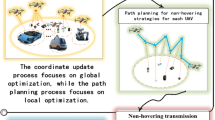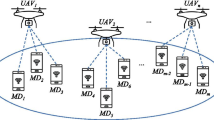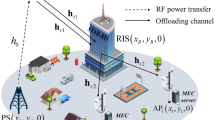Abstract
In Ultrareliable and Low Latency Communications (URLLC), balancing trade-offs between energy consumption, service availability, and strict reliability and latency requirements is a significant challenge, especially in unmanned aerial vehicle (UAV)-enabled multi-access edge computing (MEC) environments. The constraints imposed by the size, weight and power limitations of UAVs further complicate this task. This study addresses optimizing resource allocation in such environments to meet URLLC demands while minimizing power consumption and maximizing service availability. We explore the virtualization layer of the network function virtualization (NFV)-MEC architecture, incorporating node availability and power consumption alongside conflicting URLLC reliability and latency demands. We introduce an energy-aware model based on continuous-time Markov chain (CTMC) with an embedded virtual resource scaling scheme for Dynamic Resource Allocation (DRA). To solve the optimization problem related to MEC-enabled UAV node dimensioning, we propose a genetic algorithm (GA)-based solution. Our results demonstrate that the proposed GA-based approach achieves a superior balance, with up to a 44% reduction in power consumption compared to the first fit with maximum resources strategy, while also improving service availability and meeting URLLC requirements. This work provides a comprehensive analysis of key virtualization parameters and their impact on critical services within a single NFV-MEC over a UAV node, offering a robust framework for future 6 G network applications.









Similar content being viewed by others
Data availability
Data availability under request
Code availability
Code availability under request
References
Prathyusha Y, Sheu T-L (2023) Resource allocations for coexisting embb and urllc services in multi-uav aided communication networks for cellular offloading. IEEE Trans Veh Technol. https://doi.org/10.1109/TVT.2023.3340654
Ali R, Zikria YB, Bashir AK, Garg S, Kim HS (2024) Urllc for 5g and beyond: requirements, enabling incumbent technologies and network intelligence. IEEE Access 9:67064–67095. https://doi.org/10.1109/ACCESS.2021.3073806
Zhao L, Zhou G, Zheng G, Chih-Lin I, You X, Hanzo LH (2021) Open-source multi-access edge computing for 6g: Opportunities and challenges. ArXiv abs/2111.11354
Ranjha A, Javed MA, Piran MJ, Asif M, Hussien M, Zeadally S, Frnda J (2023) Towards facilitating power efficient urllc systems in uav networks under jittering. IEEE Trans Consum Electron. https://doi.org/10.1109/TCE.2023.3305550
Tian M, Li C, Hui Y, Cheng N, Yue W, Fu Y, Han Z (2023) On-demand multiplexing of embb/urllc traffic in a multi-uav relay network. IEEE Trans Intell Transp Syst. https://doi.org/10.1109/TITS.2023.3332022
Zhang Y, Zhao L, Zheng G, Chu X, Ding Z, Chen K-C (2021) Resource allocation for open-loop ultra-reliable and low-latency uplink communications in vehicular networks. IEEE Trans Veh Technol 70(3):2590–2604. https://doi.org/10.1109/TVT.2021.3061582
Falcao M, Souza CB, Balieiro A, Dias K (2021) An analytical framework for urllc in hybrid mec environments. J Supercomput 78:2245–2264. https://doi.org/10.1007/s11227-021-03945-8
Di H, Zhu X, Liu Z, Tu X (2024) Joint blocklength and trajectory optimizations for urllc-enabled uav relay system. IEEE Commun Lett 28(1):118–122. https://doi.org/10.1109/LCOMM.2023.3335655
Morabito R (2015) Power consumption of virtualization technologies: An empirical investigation. In: 2015 IEEE/ACM 8th International Conference on Utility and Cloud Computing (UCC), pp. 522–527. https://doi.org/10.1109/UCC.2015.93
Falcão M, Souza C, Balieiro A, Dias K (2023) Dynamic resource allocation for urllc in uav-enabled multi-access edge computing. In: 2023 Joint European Conference on Networks and Communications and 6G Summit (EuCNC/6G Summit), pp. 293–298. https://doi.org/10.1109/EuCNC/6GSummit58263.2023.10188346
Xue D, Guo Y, Li N et al (2023) Cross-domain coordination of resource allocation and route planning for the edge computing-enabled multi-connected vehicles. J Cloud Comput 12(1):33. https://doi.org/10.1186/s13677-023-00415-9
Elgendy IA, Meshoul S, Hammad M (2023) Joint task offloading, resource allocation, and load-balancing optimization in multi-uav-aided mec systems. Appl Sci 13(4):2625. https://doi.org/10.3390/app13042625
Chen J, Cao X, Yang P, Xiao M, Ren S, Zhao Z, Wu DO (2023) Deep reinforcement learning based resource allocation in multi-uav-aided mec networks. IEEE Trans Commun 71(1):296–309. https://doi.org/10.1109/TCOMM.2022.3226193
Safwat NE-D, Hafez IM, Newagy F (2022) 3d placement of a new tethered uav to uav relay system for coverage maximization. Electronics 11(3):385
Zhao M-M, Shi Q, Zhao M-J (2020) Efficiency maximization for uav-enabled mobile relaying systems with laser charging. IEEE Trans Wireless Commun 19(5):3257–3272. https://doi.org/10.1109/TWC.2020.2971987
Cai Y, Jiang X, Liu M, Zhao N, Chen Y, Wang X (2022) Resource allocation for urllc-oriented two-way uav relaying. IEEE Trans Veh Technol 71(3):3344–3349. https://doi.org/10.1109/TVT.2022.3143174
Iliev TB, Ivanova EP, Stoyanov IS, Mihaylov GY, Beloev IH (2021) Artificial intelligence in wireless communications - evolution towards 6g mobile networks. 2021 44th International Convention on Information, Communication and Electronic Technology (MIPRO) https://doi.org/10.23919/MIPRO52101.2021.9597147
Do QV, Pham Q-V, Hwang W-J (2022) Deep reinforcement learning for energy-efficient federated learning in uav-enabled wireless powered networks. IEEE Commun Lett 26(1):99–103. https://doi.org/10.1109/LCOMM.2021.3122129
Pham Q-V, Zeng M, Ruby R, Huynh-The T, Hwang W-J (2021) Uav communications for sustainable federated learning. IEEE Trans Veh Technol 70(4):3944–3948. https://doi.org/10.1109/TVT.2021.3065084
Hou X, Wang J, Jiang C, Zhang X, Ren Y, Debbah M (2023) Uav-enabled covert federated learning. IEEE Trans Wireless Commun 22(10):6793–6809. https://doi.org/10.1109/TWC.2023.3245621
Lu Y, Huang X, Zhang K, Maharjan S, Zhang Y (2020) Blockchain empowered asynchronous federated learning for secure data sharing in internet of vehicles. IEEE Trans Veh Technol 69(4):4298–4311. https://doi.org/10.1109/TVT.2020.2973651
Moriai S (2019) Privacy-preserving deep learning via additively homomorphic encryption. In: 2019 IEEE 26th Symposium on Computer Arithmetic (ARITH), pp. 198–198. https://doi.org/10.1109/ARITH.2019.00047
Costanzo F, Lorenzo PD, Barbarossa S (2020) Dynamic resource optimization and altitude selection in uav-based multi-access edge computing. In: ICASSP 2020 - 2020 IEEE International Conference on Acoustics, Speech and Signal Processing (ICASSP), pp. 4985–4989. https://doi.org/10.1109/ICASSP40776.2020.9053594
Yang Z, Pan C, Wang K, Shikh-Bahaei M (2019) Energy efficient resource allocation in uav-enabled mobile edge computing networks. IEEE Trans Wireless Commun 18(9):4576–4589. https://doi.org/10.1109/TWC.2019.2927313
Bekkouche O, Samdanis K, Bagaa M, Taleb T (2020) A service-based architecture for enabling uav enhanced network services. IEEE Netw 34(4):328–335. https://doi.org/10.1109/MNET.001.1900556
Emara M, ElSawy H, Filippou MC, Bauch G (2021) Spatiotemporal dependable task execution services in mec-enabled wireless systems. IEEE Wirel Commun Lett 10(2):211–215. https://doi.org/10.1109/LWC.2020.3024749
Kherraf N, Alameddine HA, Sharafeddine S, Assi CM, Ghrayeb A (2019) Optimized provisioning of edge computing resources with heterogeneous workload in iot networks. IEEE Trans Netw Serv Manage 16(2):459–474. https://doi.org/10.1109/TNSM.2019.2894955
Fautrel T, George L, Fauberteau F, Grandpierre T (2019) An hypervisor approach for mixed critical real-time uav applications. In: 2019 IEEE International Conference on Pervasive Computing and Communications Workshops (PerCom Workshops), pp. 985–991. https://doi.org/10.1109/PERCOMW.2019.8730705
Mavridis I, Karatza HD (2019) Combining containers and virtual machines to enhance isolation and extend functionality on cloud computing. Future Gener Comput Syst 94:674–696
Felter W, Ferreira A, Rajamony R, Rubio J (2015) An updated performance comparison of virtual machines and linux containers. In: 2015 IEEE International Symposium on Performance Analysis of Systems and Software (ISPASS), pp. 171–172. IEEE, ???
Pahl C, Brogi A, Soldani J, Jamshidi P (2017) Cloud container technologies: a state-of-the-art review. IEEE Trans Cloud Comput 7(3):677–692
Kulkarni SG, Liu G, Ramakrishnan KK, Arumaithurai M, Wood T, Fu X (2020) Reinforce: achieving efficient failure resiliency for network function virtualization-based services. IEEE/ACM Trans Netw 28(2):695–708. https://doi.org/10.1109/TNET.2020.2969961
Kaur K, Dhand T, Kumar N, Zeadally S (2017) Container-as-a-service at the edge: Trade-off between energy efficiency and service availability at fog nano data centers. IEEE Wirel Commun 24(3):48–56. https://doi.org/10.1109/MWC.2017.1600427
Anand A, Veciana G (2018) Resource allocation and harq optimization for urllc traffic in 5g wireless networks. IEEE J Sel Areas Commun 36(11):2411–2421. https://doi.org/10.1109/JSAC.2018.2874122
Balieiro AM, Falcão M, Dias KL (2019) An evolutionary scheme for secondary virtual networks mapping onto cognitive radio substrate. Wirel Commun Mob Comput 2019:1872765–1187276519. https://doi.org/10.1155/2019/1872765
Chen S, Newman TR, Evans JB, Wyglinski AM (2010) Genetic algorithm-based optimization for cognitive radio networks. In: 2010 IEEE Sarnoff Symposium, pp. 1–6. https://doi.org/10.1109/SARNOF.2010.5469780
Benamer AR, Boussetta K, Hadj-Alouane NB (2021) A genetic algorithm for the placement of latency-sensitive multiplayer game servers in the fog. In: 2021 IEEE Global Communications Conference (GLOBECOM), pp. 1–6. https://doi.org/10.1109/GLOBECOM46510.2021.9685952
Ruiz L, Durán RJ, Miguel I, Khodashenas PS, Pedreno-Manresa J-J, Merayo N, Aguado JC, Pavón-Mariño P, Siddiqui S, Mata J, Fernández P, Lorenzo RM, Abril EJ (2018) A genetic algorithm for vnf provisioning in nfv-enabled cloud/mec ran architectures. Applied Sciences
Balieiro A, Yoshioka P, Dias K, Cavalcanti D, Cordeiro C (2014) A multi-objective genetic optimization for spectrum sensing in cognitive radio. Expert Syst Appl 41(8):3640–3650. https://doi.org/10.1016/j.eswa.2013.12.010
Acknowledgements
This work was supported by the National Council for Scientific and Technological Development (CNPq) Project No. 433142/2018-9, the Coordenação de Aperfeiçoamento de Pessoal de Nível Superior - Brasil (CAPES) - Finance Code 001, the CNPq Research Productivity Fellowship (Grant No. 312831/2020-0) and the Pernambuco Research Foundation (FACEPE) (Grant No. IBPG-0096\(-\)1.03/16).
Author information
Authors and Affiliations
Contributions
This paper is equally contributed by each author as everyone wrote a section of it. Besides, there was collaborative efforts in brainstorming the idea of this paper, proofread and formatting of this paper.
Corresponding authors
Ethics declarations
Conflict of interest
The authors declare there is no conflict of interest.
Ethical approval
Ethics approval and consent to participate
Additional information
Publisher's Note
Springer Nature remains neutral with regard to jurisdictional claims in published maps and institutional affiliations.
Rights and permissions
Springer Nature or its licensor (e.g. a society or other partner) holds exclusive rights to this article under a publishing agreement with the author(s) or other rightsholder(s); author self-archiving of the accepted manuscript version of this article is solely governed by the terms of such publishing agreement and applicable law.
About this article
Cite this article
Falcão, M., Souza, C.B., Balieiro, A. et al. Resource allocation for UAV-enabled multi-access edge computing. J Supercomput 80, 22770–22802 (2024). https://doi.org/10.1007/s11227-024-06314-3
Accepted:
Published:
Issue Date:
DOI: https://doi.org/10.1007/s11227-024-06314-3




